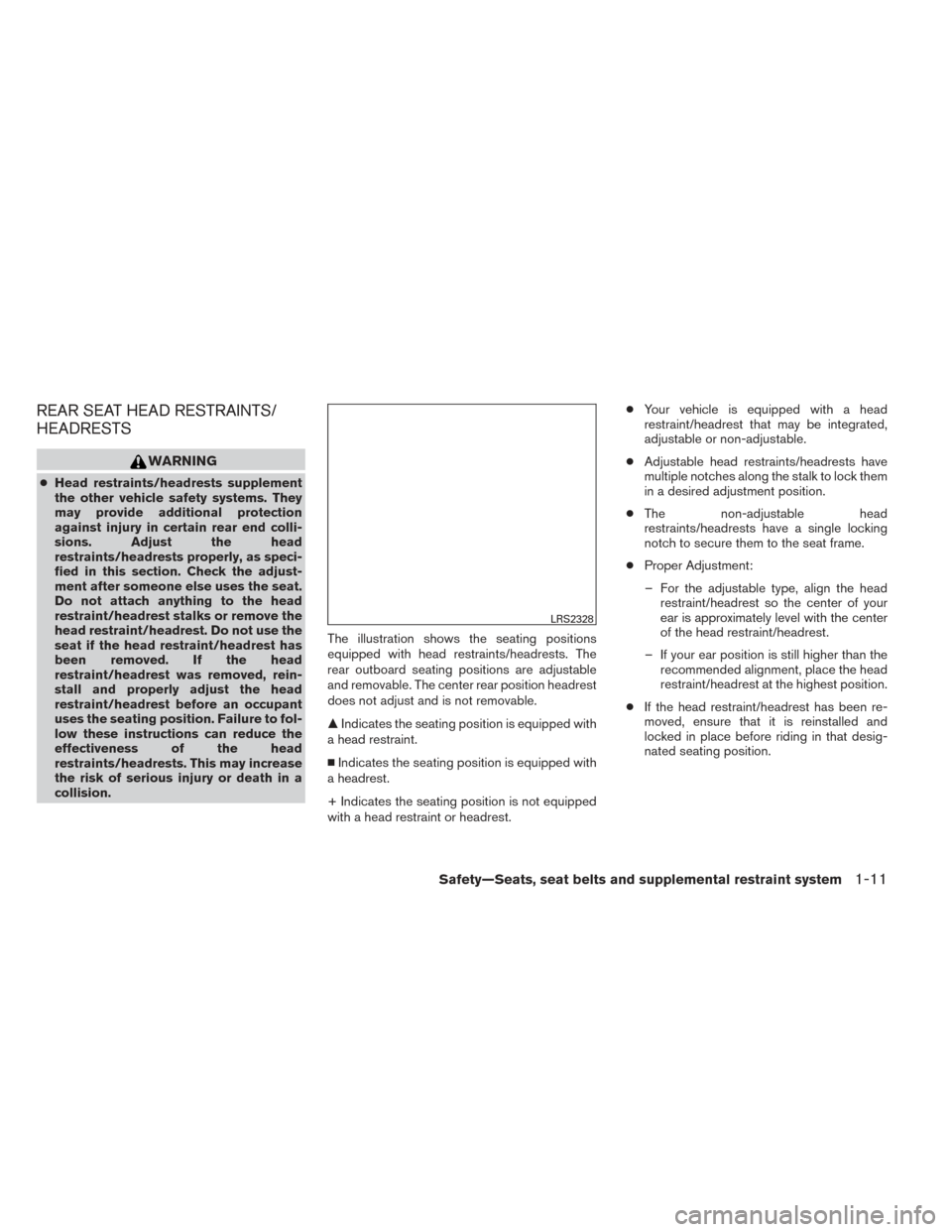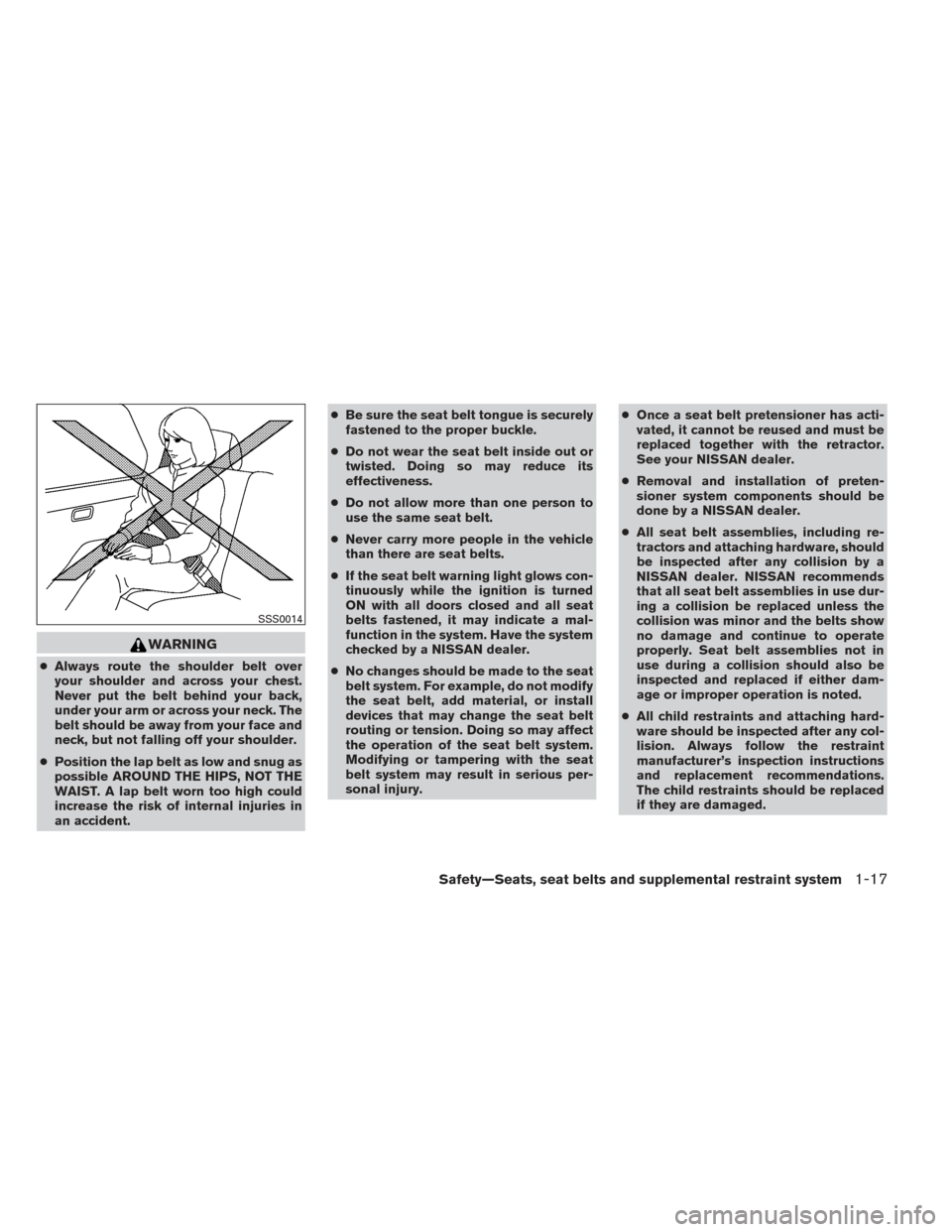Page 27 of 428
For non-adjustable head restraint/
headrest
Make sure the head restraint/headrest is posi-
tioned so the lock knob is engaged in the notch
before riding in that designated seating position.
To raise the head restraint/headrest,
pull it up.
Make sure the head restraint/headrest is posi-
tioned so the lock knob is engaged in the notch
before riding in that designated seating position.
To lower, push and hold the lock knob
and push the head restraint/headrest
down.
Make sure the head restraint/headrest is posi-
tioned so the lock knob is engaged in the notch
before riding in that designated seating position.
LRS2351LRS2305LRS2306
1-10Safety—Seats, seat belts and supplemental restraint system
Page 28 of 428

REAR SEAT HEAD RESTRAINTS/
HEADRESTS
WARNING
●Head restraints/headrests supplement
the other vehicle safety systems. They
may provide additional protection
against injury in certain rear end colli-
sions. Adjust the head
restraints/headrests properly, as speci-
fied in this section. Check the adjust-
ment after someone else uses the seat.
Do not attach anything to the head
restraint/headrest stalks or remove the
head restraint/headrest. Do not use the
seat if the head restraint/headrest has
been removed. If the head
restraint/headrest was removed, rein-
stall and properly adjust the head
restraint/headrest before an occupant
uses the seating position. Failure to fol-
low these instructions can reduce the
effectiveness of the head
restraints/headrests. This may increase
the risk of serious injury or death in a
collision. The illustration shows the seating positions
equipped with head restraints/headrests. The
rear outboard seating positions are adjustable
and removable. The center rear position headrest
does not adjust and is not removable.
�
Indicates the seating position is equipped with
a head restraint.
� Indicates the seating position is equipped with
a headrest.
+ Indicates the seating position is not equipped
with a head restraint or headrest. ●
Your vehicle is equipped with a head
restraint/headrest that may be integrated,
adjustable or non-adjustable.
● Adjustable head restraints/headrests have
multiple notches along the stalk to lock them
in a desired adjustment position.
● The non-adjustable head
restraints/headrests have a single locking
notch to secure them to the seat frame.
● Proper Adjustment:
– For the adjustable type, align the head restraint/headrest so the center of your
ear is approximately level with the center
of the head restraint/headrest.
– If your ear position is still higher than the recommended alignment, place the head
restraint/headrest at the highest position.
● If the head restraint/headrest has been re-
moved, ensure that it is reinstalled and
locked in place before riding in that desig-
nated seating position.
LRS2328
Safety—Seats, seat belts and supplemental restraint system1-11
Page 29 of 428
Adjustable head restraint/headrest
components
1. Removable head restraint/headrest
2. Multiple notches
3. Lock knob
4. Stalks
Non-adjustable head restraint/
headrest components
1. Removable head restraint/headrest
2. Single Notch
3. Lock knob
4. Stalks
Removal
Use the following procedure to remove the head
restraints/headrests.1. Adjust the seat or seatback as necessary.
2. Push and hold the lock knob.
3. Pull the head restraint/headrest up until it is removed from the seat.
4. Store the head restraint/headrest properly so it is not loose in the vehicle.
5. Reinstall the head restraint/headrest and properly adjust the seat or seatback before
an occupant uses the seating position.
LRS2300LRS2299LRS2080
1-12Safety—Seats, seat belts and supplemental restraint system
Page 30 of 428
Install
1. Align the head restraint/headrest stalks withthe holes in the seat. Make sure the head
restraint/headrest is facing the correct di-
rection.
2. Push the head restraint/headrest down until it locks in place.
For adjustable head restraint/headrest
Adjust the head restraint/headrest so the center
is level with the center of your ears. If your ear
position is still higher than the recommended
alignment, place the head restraint/headrest at
the highest position.
For non-adjustable head restraint/
headrest
Make sure the head restraint/headrest is posi-
tioned so the lock knob is engaged in the notch
before riding in that designated seating position.
LRS2081WRS0134LRS2351
Safety—Seats, seat belts and supplemental restraint system1-13
Page 31 of 428
To raise the head restraint/headrest,
pull it up.
Make sure the head restraint/headrest is posi-
tioned so the lock knob is engaged in the notch
before riding in that designated seating position.
To lower, push and hold the lock knob
and push the head restraint/headrest
down.
Make sure the head restraint/headrest is posi-
tioned so the lock knob is engaged in the notch
before riding in that designated seating position.
LRS2305LRS2306
1-14Safety—Seats, seat belts and supplemental restraint system
Page 32 of 428
PRECAUTIONS ON SEAT BELT
USAGE
If you are wearing your seat belt properly ad-
justed and you are sitting upright and well back in
your seat with both feet on the floor, your chances
of being injured or killed in an accident and/or the
severity of injury may be greatly reduced.
NISSAN strongly encourages you and all of your
passengers to buckle up every time you drive,
even if your seating position includes a supple-
mental air bag.
Most U.S. states and Canadian provinces or
territories specify that seat belts be worn at
all times when a vehicle is being driven.
SSS0136
SEAT BELTS
Safety—Seats, seat belts and supplemental restraint system1-15
Page 33 of 428
WARNING
●Every person who drives or rides in this
vehicle should use a seat belt at all
times. Children should be properly re-
strained in the rear seat and, if appro-
priate, in a child restraint.
WARNING
● The seat belt should be properly ad-
justed to a snug fit. Failure to do so may
reduce the effectiveness of the entire
restraint system and increase the
chance or severity of injury in an acci-
dent. Serious injury or death can occur if
the seat belt is not worn properly.
SSS0134SSS0016
1-16Safety—Seats, seat belts and supplemental restraint system
Page 34 of 428

WARNING
●Always route the shoulder belt over
your shoulder and across your chest.
Never put the belt behind your back,
under your arm or across your neck. The
belt should be away from your face and
neck, but not falling off your shoulder.
● Position the lap belt as low and snug as
possible AROUND THE HIPS, NOT THE
WAIST. A lap belt worn too high could
increase the risk of internal injuries in
an accident. ●
Be sure the seat belt tongue is securely
fastened to the proper buckle.
● Do not wear the seat belt inside out or
twisted. Doing so may reduce its
effectiveness.
● Do not allow more than one person to
use the same seat belt.
● Never carry more people in the vehicle
than there are seat belts.
● If the seat belt warning light glows con-
tinuously while the ignition is turned
ON with all doors closed and all seat
belts fastened, it may indicate a mal-
function in the system. Have the system
checked by a NISSAN dealer.
● No changes should be made to the seat
belt system. For example, do not modify
the seat belt, add material, or install
devices that may change the seat belt
routing or tension. Doing so may affect
the operation of the seat belt system.
Modifying or tampering with the seat
belt system may result in serious per-
sonal injury. ●
Once a seat belt pretensioner has acti-
vated, it cannot be reused and must be
replaced together with the retractor.
See your NISSAN dealer.
● Removal and installation of preten-
sioner system components should be
done by a NISSAN dealer.
● All seat belt assemblies, including re-
tractors and attaching hardware, should
be inspected after any collision by a
NISSAN dealer. NISSAN recommends
that all seat belt assemblies in use dur-
ing a collision be replaced unless the
collision was minor and the belts show
no damage and continue to operate
properly. Seat belt assemblies not in
use during a collision should also be
inspected and replaced if either dam-
age or improper operation is noted.
● All child restraints and attaching hard-
ware should be inspected after any col-
lision. Always follow the restraint
manufacturer’s inspection instructions
and replacement recommendations.
The child restraints should be replaced
if they are damaged.
SSS0014
Safety—Seats, seat belts and supplemental restraint system1-17